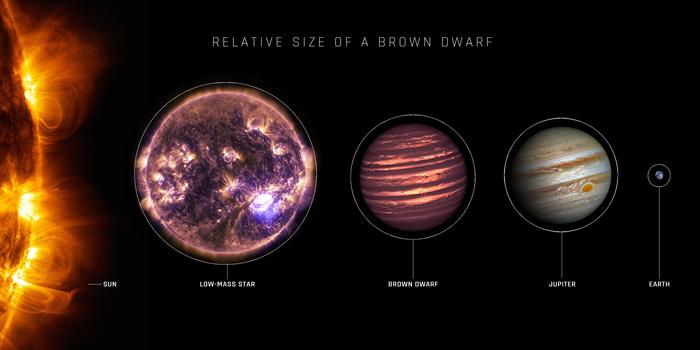Astronomers at the University of Sydney have shown that a small, faint star is the coldest on record to produce emission at radio wavelength.

Credit: NASA/JPL
Astronomers at the University of Sydney have shown that a small, faint star is the coldest on record to produce emission at radio wavelength.
The ‘ultracool brown dwarf’ examined in the study is a ball of gas simmering at about 425 degrees centigrade – cooler than a typical campfire – without burning nuclear fuel.
By contrast, the surface temperature of the Sun, a nuclear inferno, is about 5600 degrees.
While not the coldest star ever found, it is the coolest so far analysed using radio astronomy. The findings are published today in The Astrophysical Journal.
Lead author and PhD student in the School of Physics, Kovi Rose, said: “It’s very rare to find ultracool brown dwarf stars like this producing radio emission. That’s because their dynamics do not usually produce the magnetic fields that generate radio emissions detectable from Earth.
“Finding this brown dwarf producing radio waves at such a low temperature is a neat discovery.”
“Deepening our knowledge of ultracool brown dwarfs like this one will help us understand the evolution of stars, including how they generate magnetic fields.”
How the internal dynamics of brown dwarfs sometimes produce radio waves is something of an open question. While astronomers have a good idea how larger ‘main sequence’ stars like the Sun generate magnetic fields and radio emissions, it is still not fully known why fewer than 10 percent of brown dwarf stars produce such emission.
The rapid rotation of ultracool dwarfs is thought to play a part in generating their strong magnetic fields. When the magnetic field rotates at a different speed to the dwarf’s ionised atmosphere, it can create electrical current flows.
In this instance, it is thought the radio waves are being produced by the inflow of electrons to the magnetic polar region of the star, which, coupled with the rotation of the brown dwarf star, is producing regularly repeating radio bursts.
Brown dwarf stars, so called as they give off little energy or light, are not massive enough to ignite the nuclear fusion associated with other stars like our Sun.
Mr Rose said: “These stars are a kind of missing link between the smallest stars that burn hydrogen in nuclear reactions and the largest gas giant planets, like Jupiter.
The star, with the catchy name T8 Dwarf WISE J062309.94−045624.6, is located about 37 light years from Earth. It was discovered in 2011 by astronomers at Caltech in the United States.
The star’s radius is between 0.65 and 0.95 that of Jupiter. Its mass is not well understood but is at least four times more massive than Jupiter but no more than 44 times more massive. The Sun is 1000 times more massive than Jupiter.
The analysis of the star was made by Mr Rose using new data from the CSIRO ASKAP telescope in Western Australia and followed up with observations from the Australia Telescope Compact Array near Narrabri in NSW and the MeerKAT telescope in South Africa.
Professor Tara Murphy, co-author and Head of the School of Physics at the University of Sydney, said: “We’ve just started full operations with ASKAP and we’re already finding a lot of interesting and unusual astronomical objects, like this.
“As we open this window on the radio sky, we will improve our understanding of the stars around us, and the potential habitability of exoplanet systems they host.”
DOWNLOAD photos at this link.
INTERVIEWS
Kovi Rose | [email protected] || Prof Tara Murphy | [email protected]
MEDIA ENQUIRIES Marcus Strom | +61 423 982 485 | [email protected]
DECLARATION Researchers declare no conflicts.
ACKNOWLEDGEMENTS
The MeerKAT telescope is operated by the South African Radio Astronomy Observatory, which is a facility of the National Research Foundation, an agency of the Department of Science and Innovation. CSIRO’s ASKAP radio telescope is part of the Australia Telescope National Facility (ATNF). Operation of ASKAP is funded by the Australian Government with support from the National Collaborative Research Infrastructure Strategy. ASKAP uses the resources of the Pawsey Supercomputing Research Centre. Establishment of ASKAP, Inyarrimanha Ilgari Bundara, the CSIRO Murchison Radio-astronomy Observatory and the Pawsey Supercomputing Research Centre are initiatives of the Australian Government, with support from the Government of Western Australia and the Science and Industry Endowment Fund. The Australia Telescope Compact Array is part of the ATNF which is funded by the Australian Government for operation as a National Facility managed by CSIRO. We acknowledge the Gomeroi people as the Traditional Owners of the Observatory site. This publication makes use of data products from the Wide-field Infrared Survey Explorer (WISE), which is a joint project of the University of California, Los Angeles, and the Jet Propulsion Laboratory/California Institute of Technology, funded by the National Aeronautics and Space Administration.
Journal
The Astrophysical Journal
DOI
10.3847/2041-8213/ace188
Method of Research
Data/statistical analysis
Subject of Research
Not applicable
Article Title
3Periodic Radio Emission from the T8 Dwarf WISE~J062309.94$-$045624.6
Article Publication Date
13-Jul-2023
COI Statement
The authors declare no conflicts.




